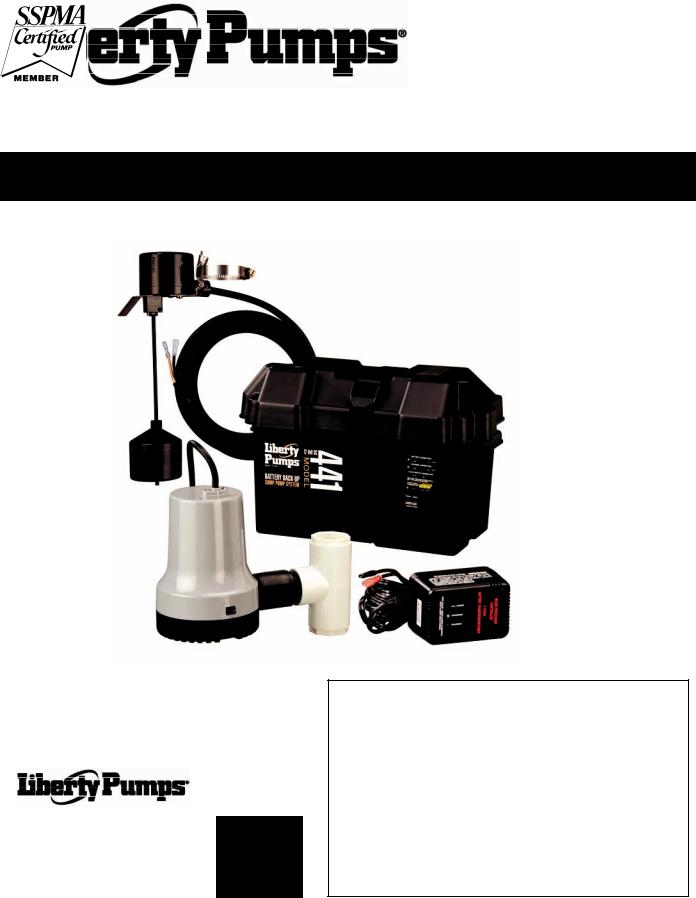Liberty Pumps 441 User Manual

Installation Manual |
4414000B |
|
|
Model 441 Battery Backup System
*Do not throw away or lose this manual.
7000 Apple Tree Avenue Bergen, NY 14416 Phone: (800) 543-2550 Fax: (585) 494-1839 www.libertypumps.com
IMPORTANT:
Prior to installation, record Model, Serial Number, and Code Number from pump nameplate for future reference.
MODEL ________________________
SERIAL ______________________
CODE ______________________
INSTALLATION
DATE _______________________
©Copyright 2009 Liberty Pumps Inc. All rights reserved |
1 |

1. General Information – All Models
The battery back-up sump pump system is not a substitute for your primary sump pump. It is designed to temporarily back up your primary sump pump during a power outage or other problem which prevents normal operation of the primary pump. Do not use this system to pump flammable liquids or chemicals. Pump clear water only with this pump.
Keep battery charger dry and protected from damage.
In an emergency (such as an extended power outage) which depletes the system deep cycle battery, your automobile battery may be temporarily substituted. Be sure to replace the system deep cycle battery as soon as possible. Use of an automobile battery instead of a deep cycle battery in this system will significantly reduce system total performance. Automobile batteries are not designed for this type of application and will be quickly ruined by the repeated charge/discharge cycling. Do not use GEL-type batteries or maintenance-free batteries with this charger. GEL-type batteries require a lower voltage than the charger is designed for; they may overcharge. Maintenance-free (sealed) batteries require a higher voltage and may never reach full charge.
•Hazardous Voltage. Can cause severe or fatal electrical shock. Do not plug in or unplug the battery charger while standing on a wet floor or in water. Be sure one hand is free when plugging in or unplugging the charger. If basement floor is wet, disconnect power to basement before walking on floor.
•DO NOT bypass grounding wires or remove ground prong from attachment plugs.
•Risk of electric shock. Always disconnect the pump from the power source before handling or making adjustments.
•Battery acid is corrosive. Do not spill on skin, clothing, or battery charger. Wear eye and head protection when working with the battery. Connect and disconnect DC output terminals only after removing the charger from the AC outlet. Never allow the DC terminals to touch each other.
•To avoid danger of fire or explosion, keep sparks and flame (pilot light) away from battery.
•The electrical connections and wiring for a pump installation should only be made by qualified personnel.
•This pump is supplied with a grounding conductor and grounding-type attachment plug. To reduce the risk of electric shock, be certain that it is connected only to a properly grounded, grounding-type 15 Amp receptacle. A ground fault circuit interrupter (GFCI) is recommended for use on any electrical appliance submerged in water.
•DO NOT use an extension cord.
•The electrical outlet shall be within the length limitations of the pump power cord, and at least 4 feet above floor level to minimize possible hazards from flood conditions.
•The installation must be in accordance with the National Electric Code, Uniform Plumbing Code, International Plumbing Code, as well as all applicable local codes and ordinances.
•Sump and sewage pumps often handle materials which could cause illness or disease. Wear adequate protective clothing when working on a used pump or piping.
•Keep clear of suction and discharge openings. To prevent injury, never insert fingers into pump while it is plugged in.
•DO NOT use this product for flammable or corrosive liquid.
•DO NOT use this product in applications where human contact with the pumped fluid is common (such as swimming pools, fountains, etc.)
•NEVER dispose of materials such as paint thinner or other chemicals down drains, as they can chemically attack and damage pump components, potentially causing product malfunction or failure.
•Use this system only for backup sump pump duty in a residential application. It is not designed as a primary sump pump.
•Risk of flooding. DO NOT run pump dry. To do so will damage seals and can cause leaking and property damage.
•DO NOT use pumps in water over 140°F (60°C).
•DO NOT use pumps in mud, sand, cement, oil or chemicals.
©Copyright 2009 Liberty Pumps Inc. All rights reserved |
2 |

•DO NOT modify the pump in any way.
•DO NOT lift or carry pump by power cord.
•DO NOT remove any tags from pump or cords.
•If pump is installed during construction before power is available, it must be protected from the environment to prevent water from entering through the cord plug end, etc.
•Keep battery charger and battery box off of the floor and in a dry, cool, well ventilated area.
•Make sure sump is clear of debris. Debris can damage the pump which can result in flooding
•Maximum vertical pumping distance is 24 feet (7.3M)
•The pump should be checked frequently for debris and/or build-up which may interfere with pump of float switch operation. The float must be free to move freely through its complete travel without any restrictions. Periodically (at least every three months), the pump should be tested to ensure proper function. This may be done by disconnecting power to the primary pump so that the water level rises to activate the back-up unit. Be sure to follow all safety precautions and remember to reconnect power to the primary pump and verify proper operation after conclusion of the test.
NOTICE: If a Carbon Monoxide (CO) sensor is installed, it must be at least 15 feet away from battery charger in order to avoid nuisance CO alarms. Please refer to your CO detector’s installation guidelines for more information.
2. Installation of Pump
BATTERY BACKUP SYSTEM
INSTALLATION AND OPERATION
NOTICE:
•Install this system during a time when the primary pump will not be needed. Gather all supplies before starting. Read all warnings and installation steps before you start.
•Be prepared for water to leak from the coupling or piping when disassembling or cutting the discharge pipe. Protect system components, tools and supplies from getting wet. Dry any work areas that get wet immediately.
BASIC TOOLS AND
MATERIALS NEEDED
•Channel locks or large pliers
•Tape measure
•Socket wrench or 5/16” Nut driver
•Side cutters
•Hacksaw (to cut PVC pipe)
•Medium size pliers
•Pencil
•Teflon tape
•PVC glue (solvent weld)
•PVC pipe cleaner
•Cloth towel
•Size 24M or 27M Marine Deep Cycle Battery Maximum battery capacity is 100 ampere-hours.
Personal injury and flood hazard. Do not turn the pump on until all the fittings are glued and the glue has dried. Loose fittings can unexpectedly disconnect from pipes and cause personal injury and flooding.
©Copyright 2009 Liberty Pumps Inc. All rights reserved |
3 |

PREPARATION FOR INSTALLATION
1.Locate the “on” water level of the primary sump pump. Mark this location on the discharge pipe with a pencil. See Figure 1.
2.Drain the sump pit. The water level must be pumped down as low as possible before going on to the next step. To drain the sump pit follow either step “2A” or “2B” (below).
2A. Raise the float on the float switch until the pump turns on. Use a wooden broom handle or a stick to do this.
2B. If the sump pump has a piggy-back type power cord, remove the float switch power cord plug from the outlet and plug the pump power cord plug directly into the outlet. See Figure 2.
3.Confirm sump has been drained and shut-off pump. NOTICE: Do not let the pump run dry. This will damage the pump.
4.Unplug the pump
Electrical shock hazard. Shock can burn or kill. Do not use metal or any other electrical conducting material to raise the float. Do not make contact with the water in the sump pit. Failure to follow this warning can result in personal injury or death.
1. Unplug the “Piggy-back” float switch cord plug and the pump power cord plug from grounded electrical outlet
2. Separate the float switch cord plug from the sump pump cord plug.
3. Plug the pump power cord plug directly into the outlet
Figure 2 - To bypass the float
©Copyright 2009 Liberty Pumps Inc. All rights reserved |
4 |
